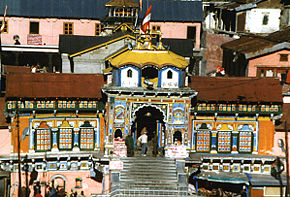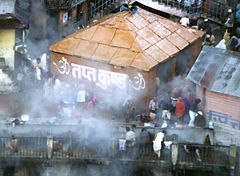Difference between revisions of "Badrinath temple" - New World Encyclopedia
Dan Davies (talk | contribs) (images OK, categories, external links checked) |
Dan Davies (talk | contribs) (→References: references added) |
||
| Line 54: | Line 54: | ||
== References == | == References == | ||
| − | + | * A Guide to Shri Badri-Kedar yatra with full description of Yamnotri, Gangotri, Kedarnath, Badrinath, and Satyapath. 1938. Rishikesh: Shri 108 Baba Kali Kamliwale Rama Nathji's Kshetra. OCLC 29257334. | |
| + | * Kumar, Dinesh. 1991. The sacred complex of Badrinath: a study of Himalayan pilgrimage. Varanasi: Kisohr [i.e. Kishor] Vidya Niketan. OCLC 38898537. | ||
| + | * Nauṭiyāla, Śivānanda. 1986. Kedāra-Badarī yātrā-darśana. Lakhanaū: Sulabha Prakāśana. OCLC 20995890. | ||
| + | * Malhotra, S. S. L. 1977. At the feet of the Badri: a trek to the shrines of Badrinath, Kedarnath, and Hemkund Sahib. New Delhi: Vikas Pub. House. OCLC 3670239. | ||
| + | * Saili, Ganesh. 1996. C̄hār Dhām̄: home of the Gods. [India]: Indus. ISBN 9788172232245. | ||
| + | * Sen Gupta, Subhadra. 2002. Badrinath and Kedarnath, the dhaams in the Himalayas. Chaar dhaam series. New Delhi: Rupa & Co. ISBN 9788171676170. | ||
| + | * Venkatraman, G. R. 1988. Chār dhām yātra = Ecstatic flight into Himalayas. Bombay: Bharatiya Vidya Bhavan. OCLC 20265368. | ||
== External links == | == External links == | ||
Revision as of 00:36, 13 June 2008
 | |
| Name: | Badrinath temple |
| Creator: | Adi Sankaracharya |
| Date built: | 9th century A.D |
| Primary deity: | Badrinarayan (Vishnu) |
| Location: | Badrinath |
Badrinath temple, sometimes called Badrinarayan temple, is situated along the Alaknanda river, in the hill town of Badrinath in Uttarakhand state in India. It is widely considered to be one of the holiest Hindu temples, and is dedicated to Lord Vishnu. The temple and town are one of the four Char Dham pilgrimage sites. It is also one of the 108 Divya Desams, holy shrines for Vaishnavites. The temple is open only six months every year (between the end of April and the beginning of November), due to extreme weather conditions in the Himalayan region.
Several murtis are worshipped in the temple. The most important is a one meter tall statue of Vishnu as Lord Badrinarayan, made of black Saligram stone. The statue is considered by many Hindus to be one of eight swayam vyakta keshtras, or self-manifested statues of Vishnu.[1] The murti depicts Vishnu sitting in meditative posture, rather than His far more typical reclining pose. In November each year, when the town of Badrinath is closed, the image is moved to nearby Jyotirmath.
Temple description
The temple is approximately 50 ft (15 metres) tall with a small cupola on top, covered with a gold gilt roof.[2] The facade is built of stone, with arched windows. A broad stairway leads up to a tall arched gateway, which is the main entrance. The architecture resembles a Buddhist vihara (temple), with the brightly painted facade also more typical of Buddhist temples. Just inside is the mandapa, a large pillared hall that leads to the garbha grha, or main shrine area. The walls and pillars of the mandapa are covered with intricate carvings.[1]
The main shrine area houses the black stone image of Lord Badrinarayan, sitting under a gold canopy, under a Badri Tree. There are fifteen more murtis around the temple that are also worshipped. These include murtis of Nara & Narayana, Narasimha (the fourth incarnation of Vishnu), Lakshmi, Narada, Ganesha, Uddhava, Kubera, Garuda (the vehicle of Lord Narayan), and Navadurga.[1] Hard sugar candy, Pongal, Tulsi, and dry fruits are the typical prasad offered at Badrinath temple.
The Tapt Kund hot sulphur springs just below the temple are considered to be medicinal—many pilgrims consider it a requirement to bathe in the springs before visiting the temple. The springs have a year-round temperature of 45°C.
Nambudiri Tradition
Although Badrinath is located in the far north of India, the head priest, or Rawal, is traditionally a Nambudiri Brahmin from the far south of India in Kerala. This tradition was begun by Adi Shankara, who was a Malayali. The Rawal is assisted by Dimripundits belonging to Village Dimmer of Garhwal. Badrinath is one of the few temples in North India which follow the ancient Tantra-Vidhi of Shrauta tradition more common in southern India.
History
Badrinath was originally established as a pilgrimage site by Adi Shankara in the ninth century. Shankara discovered the image of Badrinarayan in the Alaknanda River and enshrined it in a cave near the Tapt Kund hot springs.[2][3] In the sixteenth century, the king of Garhwal moved the murti to the present temple.[2]
The temple has undergone several major renovations, due to age and damage by avalanche.[3] In the 17th century, the temple was expanded by the kings of Garhwal. After significant damage in the great 1803 Himalayan earthquake, it was rebuilt by the King of Jaipur.[4][1]
Legend
Badrinath is mentioned in religious texts as far back as the Vedic period. Some accounts claim that the temple was built on a former Buddhist temple site.
One legend explains the reason that Vishnu is shown sitting in padmasana, rather than reclining. According to the story, Vishnu was chastised by a sage who saw Vishnu's consort Lakshmi massaging his feet. Vishnu went to Badrinath to perform austerity, meditating for a long time in padmasana.[1] To this day, the area around Badrinath attracts yogis who come for meditation and seclusion.
Another legend says that Shiva and Parvati were doing tapas in Badrinath. Vishnu came in disguise as a small boy, crying loudly and disturbing them. Parvati asked the reason for his crying and he replied that he wanted Badrinath for meditation. Shiva and Parvati found that it was Lord Narayan in disguise. They then left Badrinath and moved to Kedarnath.
According to the Srimad Bhagavatam, "There in Badrikashram the Personality of Godhead (Vishnu), in his incarnation as the sages Nara and Narayana, had been undergoing great penance since time immemorial for the welfare of all living entities."[5] The Skanda Purana states that “There are several sacred shrines in heaven, on earth, and in hell; but there is no shrine like Badrinath.” The area around Badrinath was also celebrated in Padma Purana as abounding in spiritual treasures.[2]
Panch Badri
The Badrinath temple is one of five related shrines called Panch Badri that are dedicated to worship of Lord Vishnu.[6]
- Vishal Badri: Badrinath Temple in Badrinath.
- Yogadhyan Badri: located at Pandukeshwar. It also has an image of Badrinath in meditative posture. Legend has it that King Pandu installed a statue here named Yogadhyan Badri.
- Bhavishya Badri: 17 km from Jyotirmath at Subain. Legend says that when evil is on the rise in the world, Badrinath will become inaccessible and Lord Badrinath will appear at the Bhavishya Badri temple. Thus it is the future, or Bhavishya Badri.
- Vridh Badri: 7 km from Jyotirmath in Animath. Vridh Badri means 'Old Badri.' Legend says this is where the Badrinath image was originally worshipped, before being enshrined at the current Badrinath.
- Adi Badri: 17 km from Karnaprayag. A temple complex consisting of sixteen small temples with intricate carvings houses a three foot black stone statue of Lord Vishnu.
Notes
- ↑ 1.0 1.1 1.2 1.3 1.4 Sen Gupta, Subhadra, Badrinath and Kedarnath - The Dhaams in the Himalayas, 2002. ISBN 81-7167-617-0
- ↑ 2.0 2.1 2.2 2.3 Nautiyal, Govind Prasad, Call of Badrinath, Shri Badrinath-Kedarnath Temples Committee, 1962.
- ↑ 3.0 3.1 Randhir Prakashan, The Holy Places of Uttarakhand Yatra.
- ↑ Uttaranchal Developing on Shaky Ground. Boloji.com. Retrieved October 5, 2007.
- ↑ Srimad Bhagavatam 3.4.22
- ↑ Bansal, Sunita Pant, Hindu Gods and Goddesses, Spb Enterprises Pvt Ltd (June 2005) ISBN 978-8187967729
See also
- Kedarnath Temple
- Char Dham
ReferencesISBN links support NWE through referral fees
- A Guide to Shri Badri-Kedar yatra with full description of Yamnotri, Gangotri, Kedarnath, Badrinath, and Satyapath. 1938. Rishikesh: Shri 108 Baba Kali Kamliwale Rama Nathji's Kshetra. OCLC 29257334.
- Kumar, Dinesh. 1991. The sacred complex of Badrinath: a study of Himalayan pilgrimage. Varanasi: Kisohr [i.e. Kishor] Vidya Niketan. OCLC 38898537.
- Nauṭiyāla, Śivānanda. 1986. Kedāra-Badarī yātrā-darśana. Lakhanaū: Sulabha Prakāśana. OCLC 20995890.
- Malhotra, S. S. L. 1977. At the feet of the Badri: a trek to the shrines of Badrinath, Kedarnath, and Hemkund Sahib. New Delhi: Vikas Pub. House. OCLC 3670239.
- Saili, Ganesh. 1996. C̄hār Dhām̄: home of the Gods. [India]: Indus. ISBN 9788172232245.
- Sen Gupta, Subhadra. 2002. Badrinath and Kedarnath, the dhaams in the Himalayas. Chaar dhaam series. New Delhi: Rupa & Co. ISBN 9788171676170.
- Venkatraman, G. R. 1988. Chār dhām yātra = Ecstatic flight into Himalayas. Bombay: Bharatiya Vidya Bhavan. OCLC 20265368.
External links
- Official Site of Shri Badrinath- Shri Kedarnath. Retrieved June 13, 2008.
- Badrinath. Retrieved June 13, 2008.
- Photos and story of pilgrimage to Badrinath. Retrieved June 13, 2008.
| |||||||
Credits
New World Encyclopedia writers and editors rewrote and completed the Wikipedia article in accordance with New World Encyclopedia standards. This article abides by terms of the Creative Commons CC-by-sa 3.0 License (CC-by-sa), which may be used and disseminated with proper attribution. Credit is due under the terms of this license that can reference both the New World Encyclopedia contributors and the selfless volunteer contributors of the Wikimedia Foundation. To cite this article click here for a list of acceptable citing formats.The history of earlier contributions by wikipedians is accessible to researchers here:
The history of this article since it was imported to New World Encyclopedia:
Note: Some restrictions may apply to use of individual images which are separately licensed.
